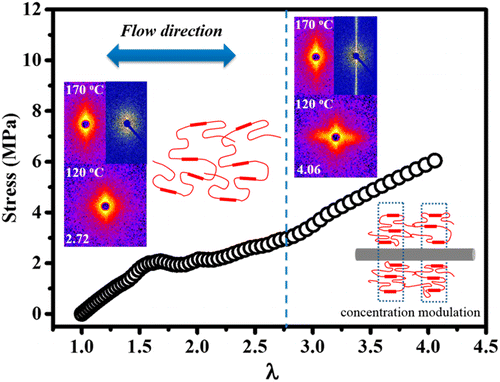[Macromolecules]Chain Deformation on the Formation of Shish Nuclei under Extension Flow: An in Situ SANS and SAXS Study
Prof. Li and Dr. yang et al. study chain conformation and morphology of nuclei/crystal by means of a combination of in situ SANS, SR-SAXS, and extensional rheometer, where a lightly cross-linked deuterated PE (D-PE)/hydrogenated PE (H-PE) blend is employed to serve as a dynamic asymmetric system with cross-linked network and free chain and to avoid phase separation.
By combining extensional rheological and in situ small-angle neutron and synchrotron X-ray scattering (SANS, SR-SAXS) techniques, the correlation between chain deformation and morphology of nucleus in a lightly cross-linked deuterated PE (D-PE)/hydrogenated PE (H-PE) blend has been studied at different draw ratios. The deformation of molecular chain obtained by SANS shows that shish forms at a rather small chain deformation of about 1.3, which does not support either coil−stretch transition or the simple stretch network model. Combining these data with the SAXS results, we speculate that the conformation ordering couples with density, instead of single chain conformation, is the key factor for shish formation. Meanwhile, due to the different alignment of the center of mass of the stretched network in samples with different draw ratios, a periodic concentration modulation of D-PE appears after crystallization of the samples stretched to the hardening zone, which, however, does not occur under the small draw ratio.
This work is supported by the National Natural Science Foundation of China (51633009, 51325301, and 51227801).

Stress−draw ratio curve and the selected in situ 2D SAXS
patterns and in situ 2D SANS patterns of XL-D/H-PE with different draw ratio


